Hydration Pack Shootout
Sean
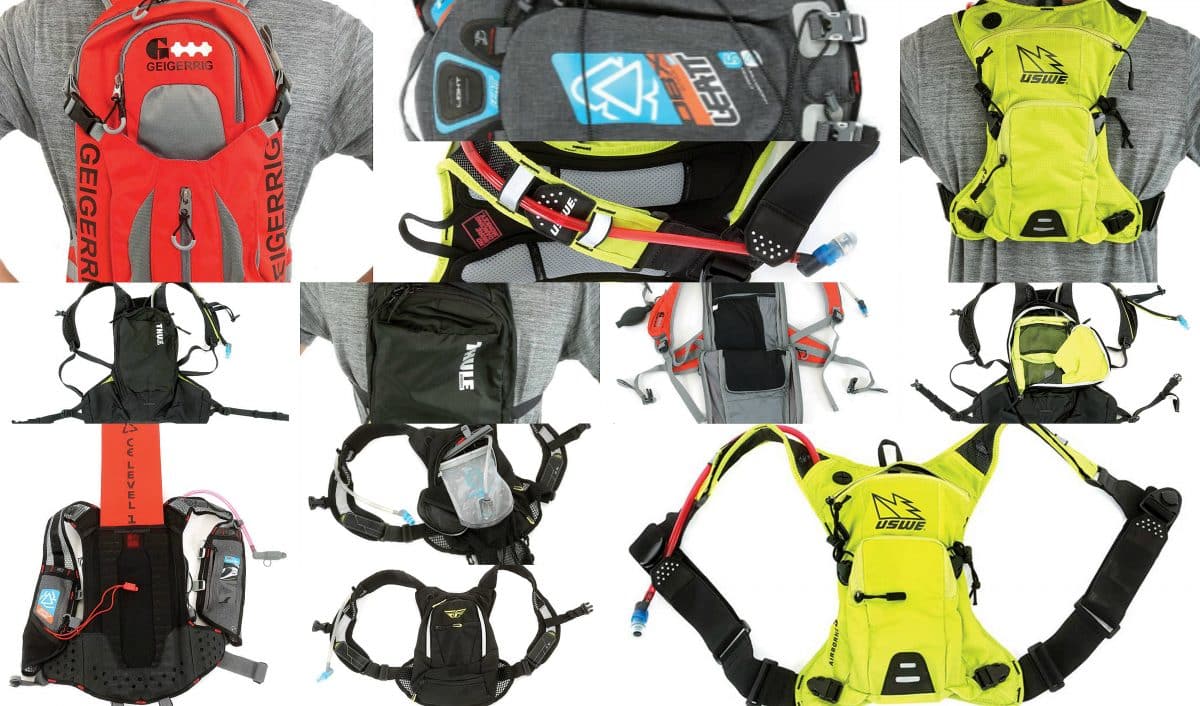
You might have the coolest bike on the trails, but without proper hydration, you’ll just be pedaling squares. Taking the proper steps to hydrate your body will help keep you at peak performance and will ensure you have more fun, but we’re not going to sit here and lecture you on the importance of consuming H2O. As a mountain biker, you probably already know how important it is to drink water, and if you don’t, you’re bound to find out soon enough. For many riders, a hydration pack is the best solution for carrying water and all other essential items. Some of our test riders have found storage solutions to ride packless; however, all of them know there’s no substitute for a pack when it comes to long epic days on the bike. 6 packs go back to back to see which will benefit riders best.
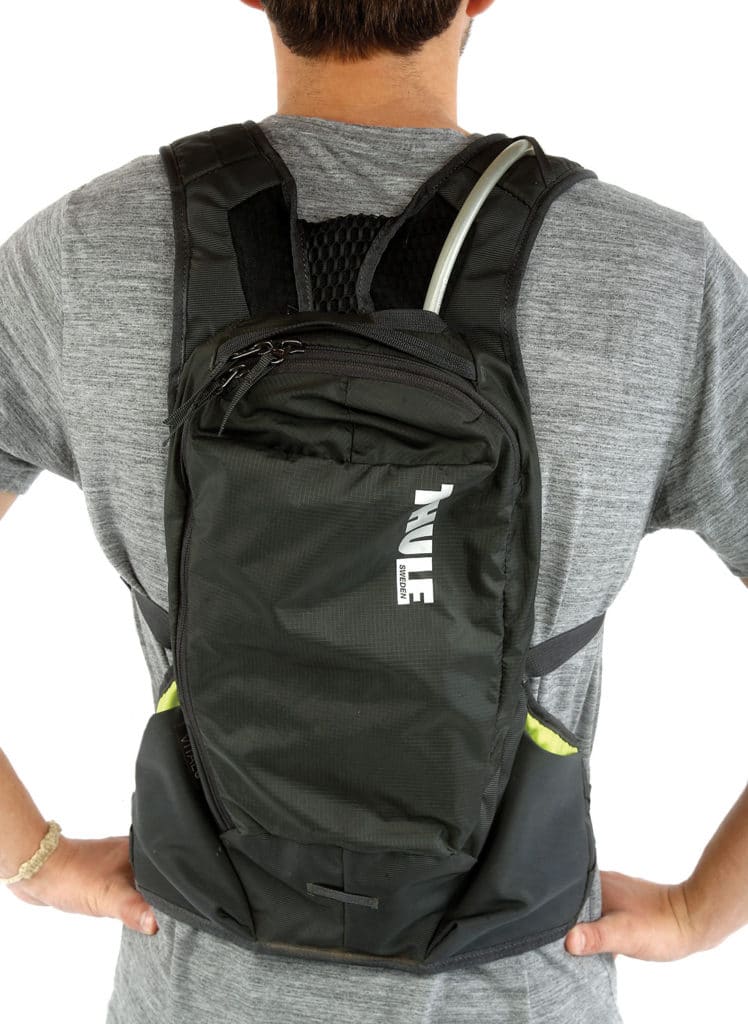
Established in Sweden in 1942, Thule has become one of the top bike and cargo rack companies in the world. Thule decided to step into a new market and build off its line of computer bags and backpacks, creating its first-ever line of hydration packs. Thule is no stranger to making well-organized lifestyle backpacks, so when we heard about its new Vital series, we knew we had to bring one into our shootout.
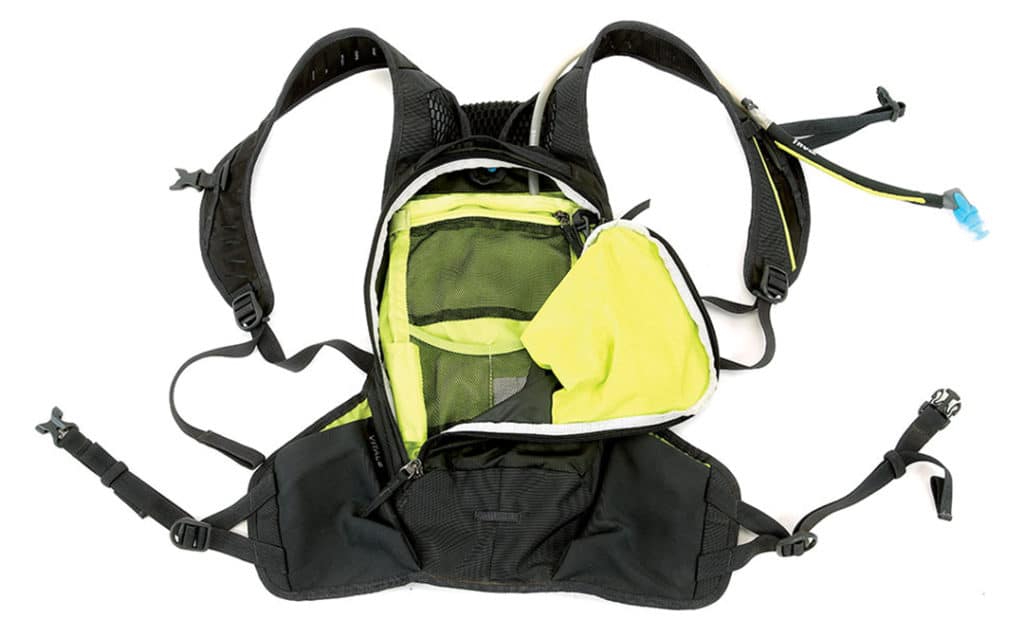
Tech features: The Vital lineup offers three sizes—3 liters, 6 liters and 8 liters. We opted to test the Vital 6, which features a 6-liter bag with a 2.5-liter bladder. The bag has a host of features inside and out that make it incredibly user-friendly out on the trails. The bag has an upper sternum strap and lower strap around the waist to keep it secure when the trails get rowdy. Thule then added its ReTrakt magnetic hose return system, which prevents the hose from flapping around and makes it easy to grab and use. The Vital has multiple storage pockets, allowing riders to stay organized. A special sleeve was added inside the bag for holding either a tire pump or shock pump. The open pockets on the waist straps make items such as tools or nutrition readily accessible. The Vital also features a soft, lined carry ample amounts of water, an extra tube, spare tools and a lightweight rain jacket can be the difference between a miserable ride and an awesome adventure. Another benefit of a good hydration pack is the protection they offer. Many enduro racers in the pro and amateur ranks are now sporting hydration packs with back protectors built into them. So, how do you determine which hydration pack is best for you? Whether you’re looking for a small lightweight pack that won’t move around or a larger pack that can carry everything but the kitchen sink, we have you covered. The EBA crew has gathered seven popular hydration packs to put them to the test so we can help you find the best pack for you and your riding style.The pocket at the top of the bag that works great for storing your cell phone or glasses. The Vital 6 sells for $120.
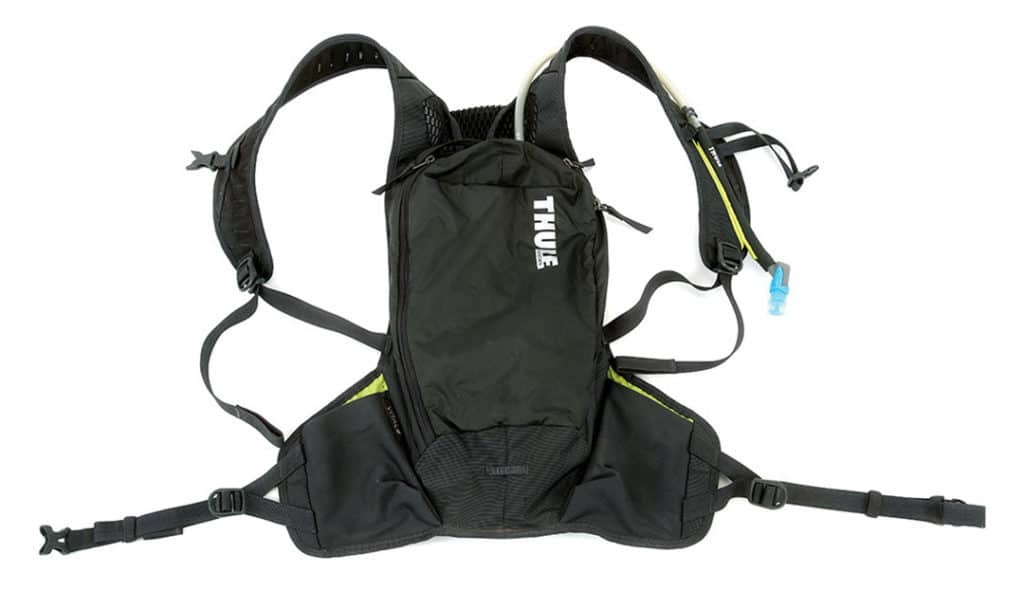
Field test results: The Vital 6 was one of our favorite bags in the shootout due to its comfortable fit and well-thought-out design. The magnetic hose return system was a great feature, and the inside of this bag had more than enough pockets for all of our essential items. One feature that took our test riders a little time to get used to was that the zipper on the main compartment only opens to one side. This helps prevent items from falling out, but with everything put away in its own pocket, it seemed like overkill. That said, Thule did an excellent job designing its first hydration pack.
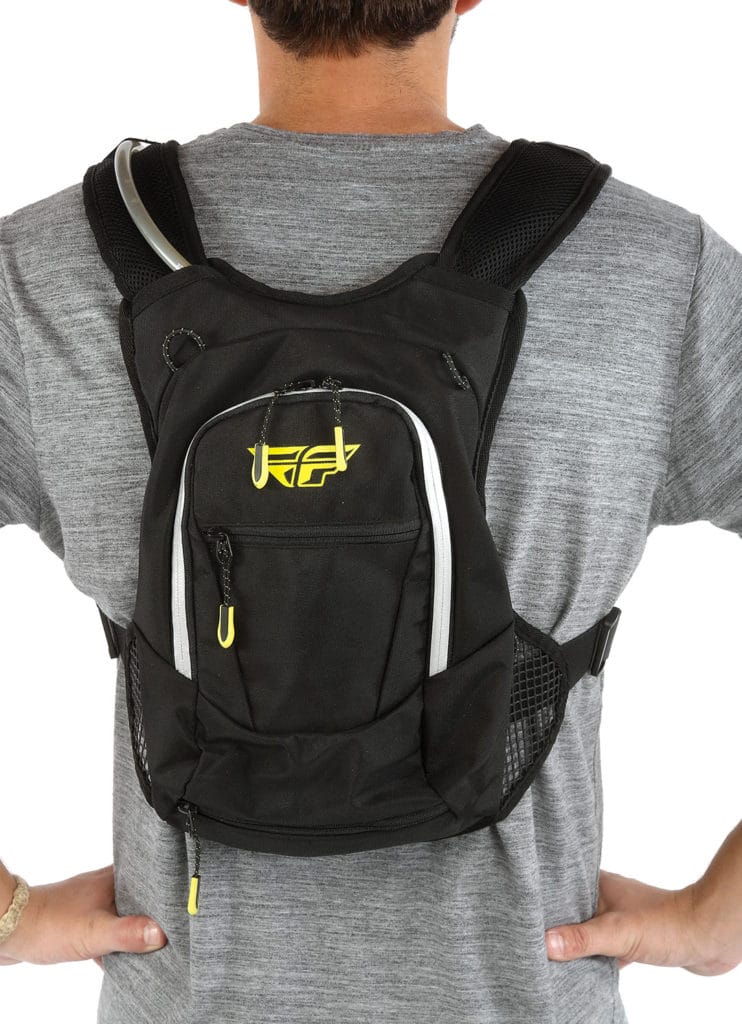
FLY XC30
Fly Racing was established in 1998 and started out making motorcycle handlebars and helmets. The company, exclusively distributed by Western Power Sports (WPS), has seen rapid growth in the powersports world and, most recently in the mountain bike world, working with many top-notch athletes, such as Bernard Kerr, Barry Nobles, Kyle Warner and the Factory KHS downhill team. Fly Racing has years of experience manufacturing gear, helmets and more, so we jumped at the opportunity to test one of its hydration packs.
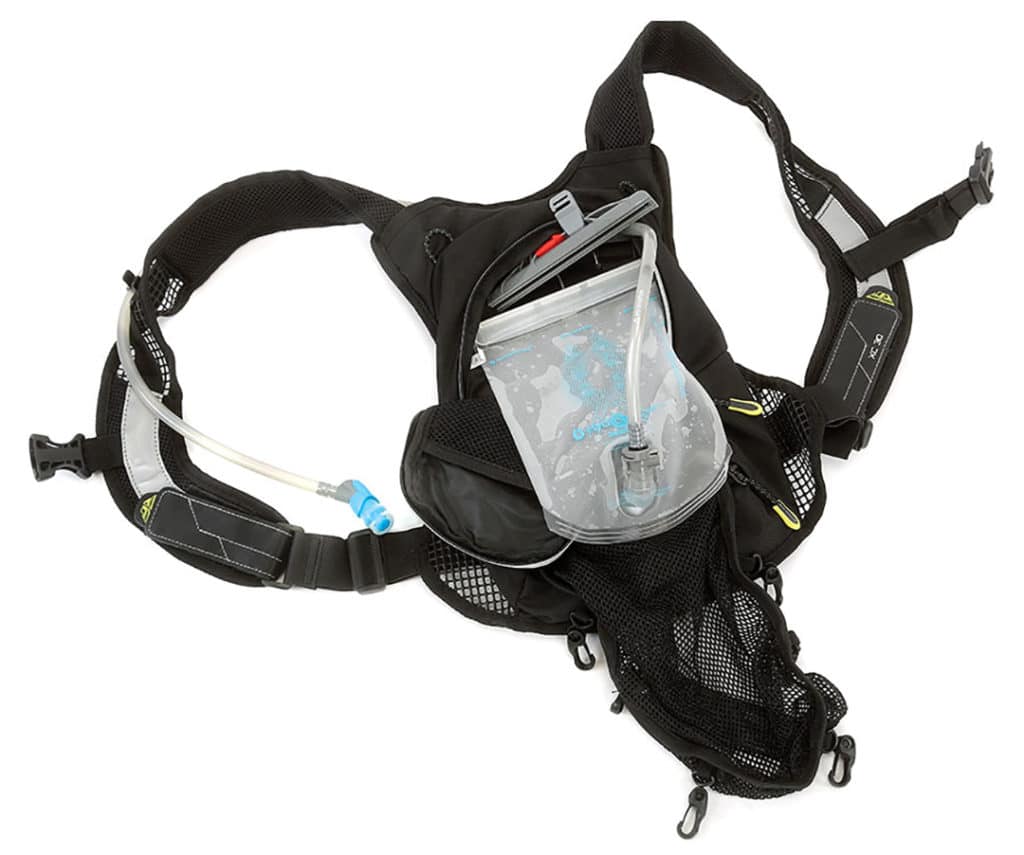
Tech features: The XC line from Fly is sold in three sizes, ranging from a small 30-fluid-ounce pack, which we tested here, up to a 100-fluid-ounce pack. The largest pack sells for $100 and has ample storage for epic rides. Our smaller test pack featured adjustable Velcro straps and a sternum strap to ensure a comfortable fit. A deployable cargo net sits inside the bottom compartment and attaches to loops on the bag, adding to the storage capacity. The main compartment holds the 1-liter bladder in a pouch, leaving the rest of the pack free for tubes, tools and other items. An outside zipper pocket provides additional storage. Fly sells this pack for just $60, making it the least expensive of all the packs we tested.
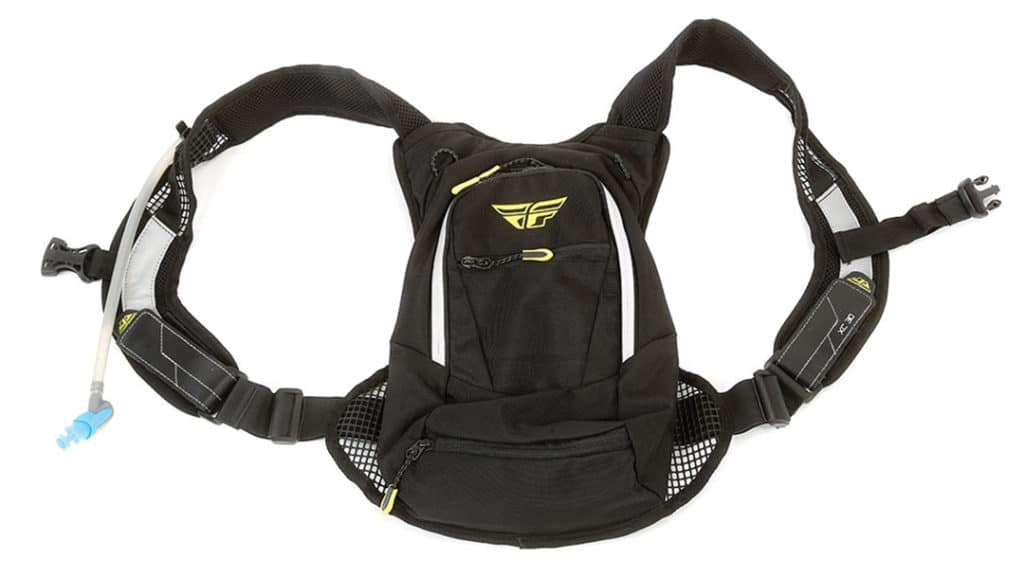
Field test results: Although the XC30 was the least expensive pack in our test, Fly didn’t compromise on construction quality. Fly did a great job making a bag that looks and feels durable. The XC30 is a small bag, so it’s not our first choice for longer rides; however, for quick rides, it was perfect. The bag has a lightweight feel, and the straps are breathable, contributing to its overall comfort. Most of our test riders wore the pack high and tight to prevent it from moving around. One issue our testers had was that the hose is fairly long and bounces around. Trimming the hose shorter or making sure it stays tucked into the pack could help solve this problem. Overall, Fly’s XC30 is ideal for short rides, providing just enough water and storage space at a great price.
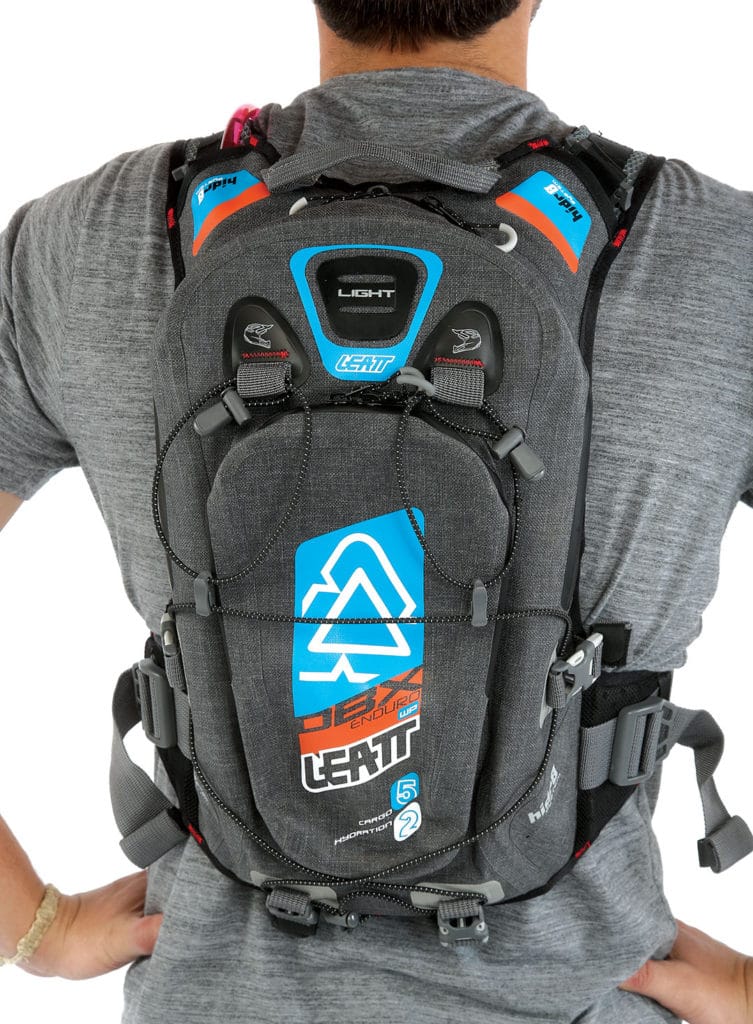
Leatt is well known in the motorcycle and bicycle industries for being a leader in innovative protective equipment. The company was created by Dr. Chris Leatt after his son witnessed the death of a fellow rider. Dr. Leatt, determined to make a difference, began designing neck braces and sold his first one in South Africa in 2004. The company now offers a large assortment of helmets, gear, pads and, of course, neck braces. Leatt wanted to develop hydration packs that were not only full of features but also offered protection to help keep riders safe out on the trails.
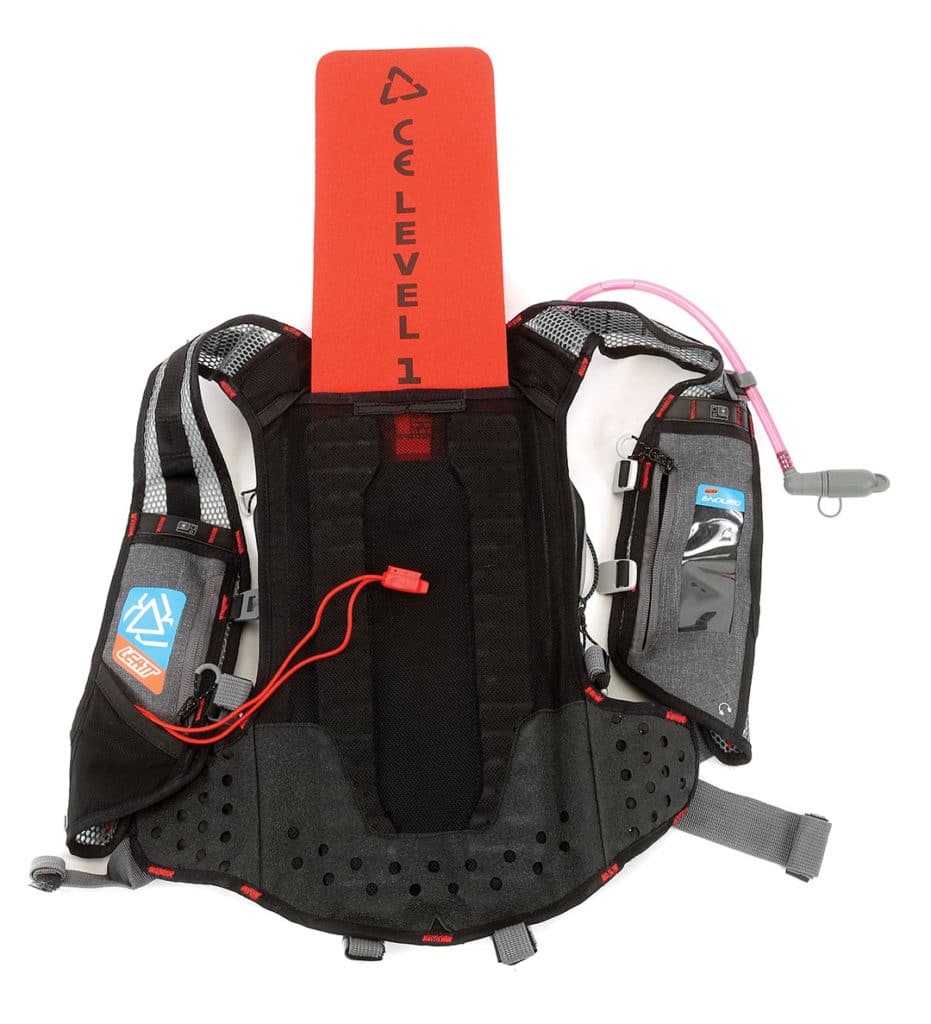
Tech features: The DBX Enduro Lite 2.0 is designed with the enduro racer in mind. This pack’s main feature is its CE Level 1 back protector; however, Leatt also packed in many other awesome features. The DBX is a 7-liter bag with a 2-liter bladder and a waterproof outer shell. The pack features a sturdy harness that keeps the DBX in place while riding and has additional storage compartments on the shoulder straps. Riders can run the hose in two positions—either over the shoulder or under the arm. The DBX has a helmet mount, plenty of storage space and very durable construction. The bladder sits up against a heat-reflective panel to help keep your water cool, and cargo straps are placed at the bottom of the pack so riders can store a jacket or pads. The DBX sells for $140.
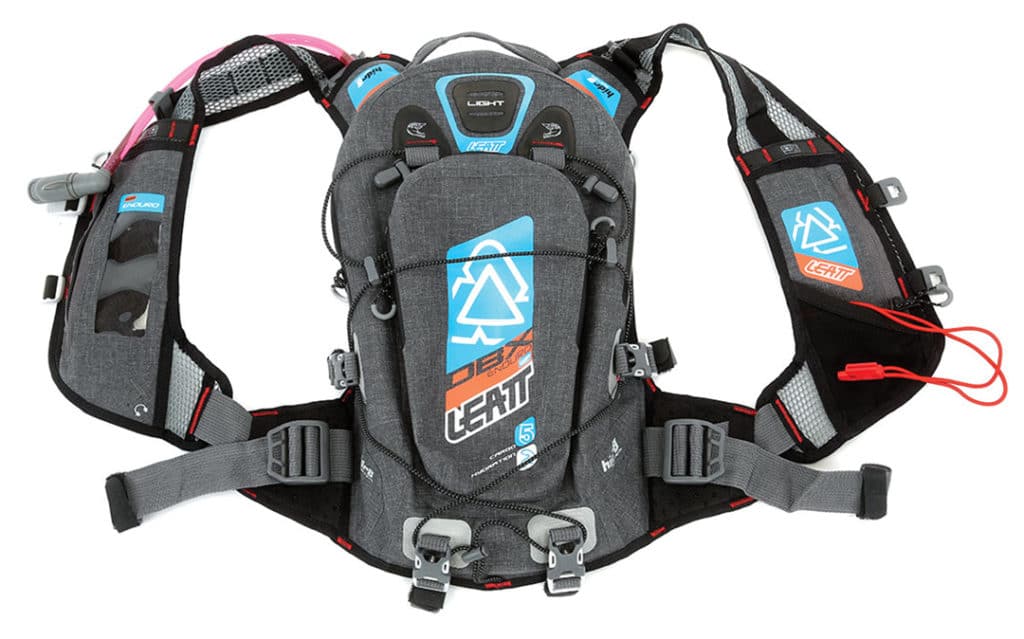
Field test results: The DBX looks and feels well built and had the best harness out of all the packs we tested. Our test riders felt comfortable riding with the pack and confident knowing it offered back protection. The DBX is as close to perfect as it can get on the outside, but the inside could use a little help. The two main storage pockets have no organization other than the small removable tool pouch. After a long day on the trails, our test rider’s gear was scrambled like a dozen eggs. The DBX is still a great pack, however, and would be a great option for a hard-core enduro racer due to its snug fit and protective back plate.
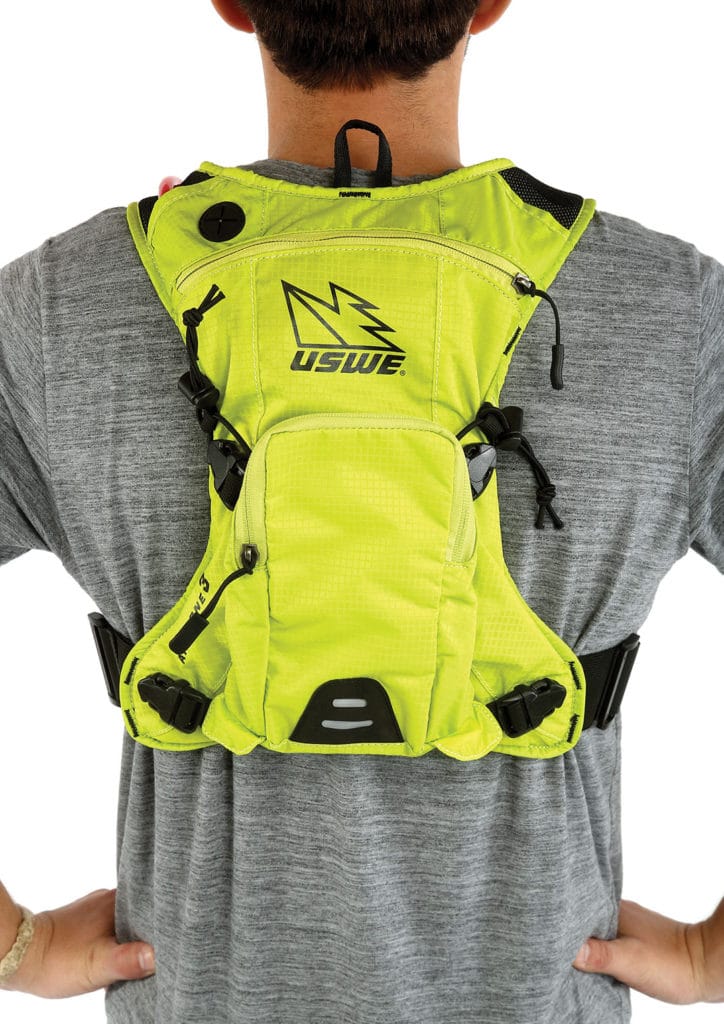
The founders of USWE (pronounced “you-swee”) grew up riding their bikes in the Swedish countryside, filling their backpacks with all the water, food and gear they needed for epic rides. They quickly found that many of the bags they were using were designed for hikers and not riders, so they purchased a sewing machine and set out to build packs by riders for riders. USWE was officially launched in 2007 with the goal of making a pack that would be 100 percent bounce-free due to a unique four-point suspension design. USWE quickly came up with the slogan “No more dancing monkey” to describe just how well these new packs worked. We decided to test an offering from USWE to see how this fairly new company compared with the rest.
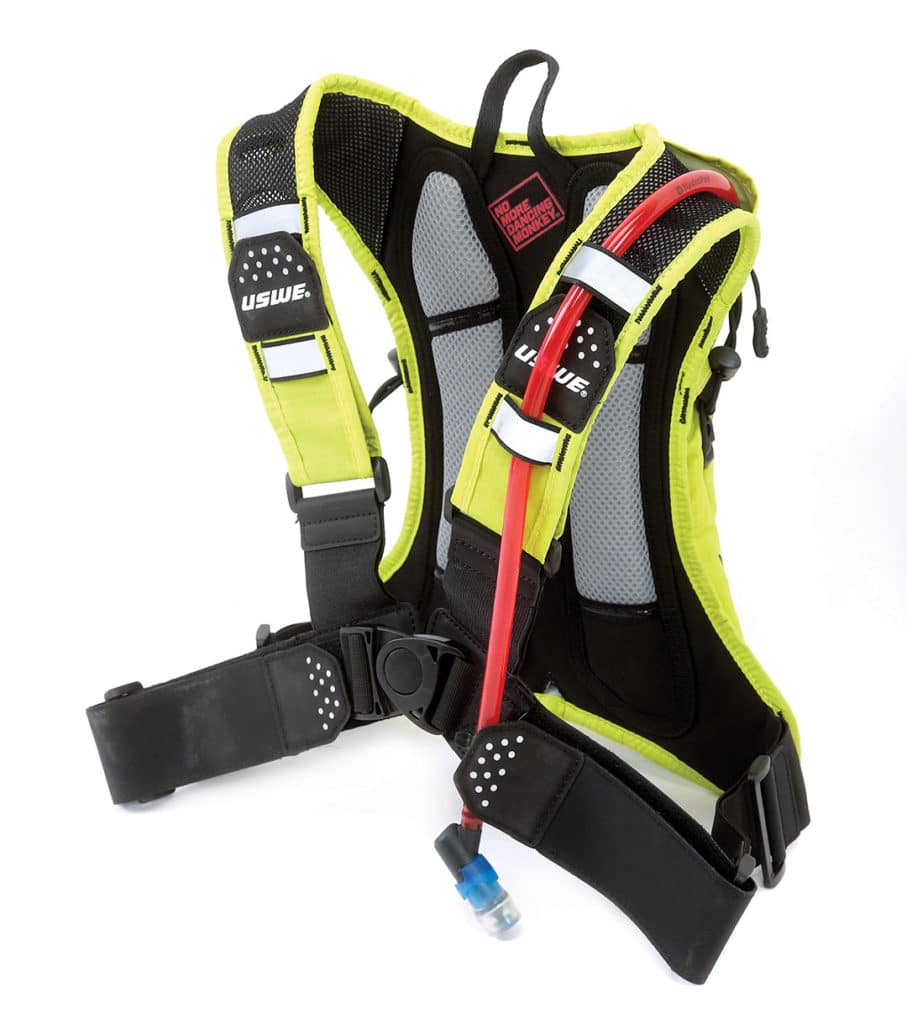
Tech features: The Airborne series from USWE is sold in a few different sizes, ranging from a junior 2-liter size up to a large 15-liter bag designed to carry anything and everything a rider might need. The Airborne 3 we tested is a 3-liter bag with a 2-liter bladder. USWE claims this pack is ideal for racers looking to carry the bare minimum, which we would have to agree with. The Airborne is a small pack that only has room for the essentials, but it makes up for it by carrying plenty of water. The key feature of this pack is its four-point harness that holds the pack high and tight on a rider’s back. Velcro-adjustable straps allow riders to fine-tune the fit, and USWE added ventilation to the back panels for additional comfort. The Airborne 3 sells for $113.
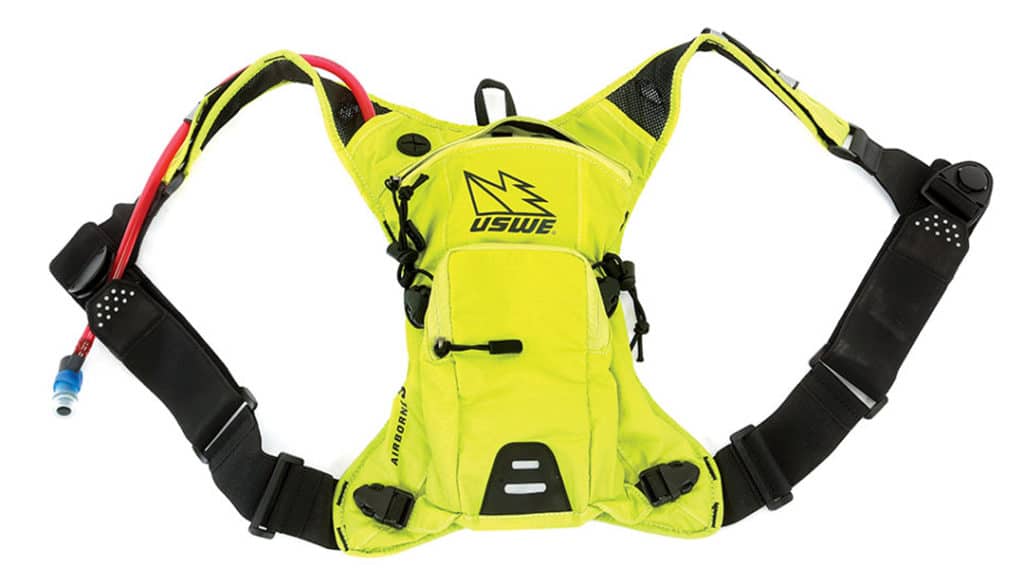
Field test results: The Airborne was the smallest pack in our shootout, making it hard to fit everything we needed into it; however, with a little force, we managed to pack in enough gear to get us out of most trail-side problems. The pack’s 2-liter bladder held more than enough water for medium to short rides, and the four-point harness held the pack in place really well. Our testers agreed that this pack would be ideal for cross-country racers looking to carry extra water in a minimalistic pack.
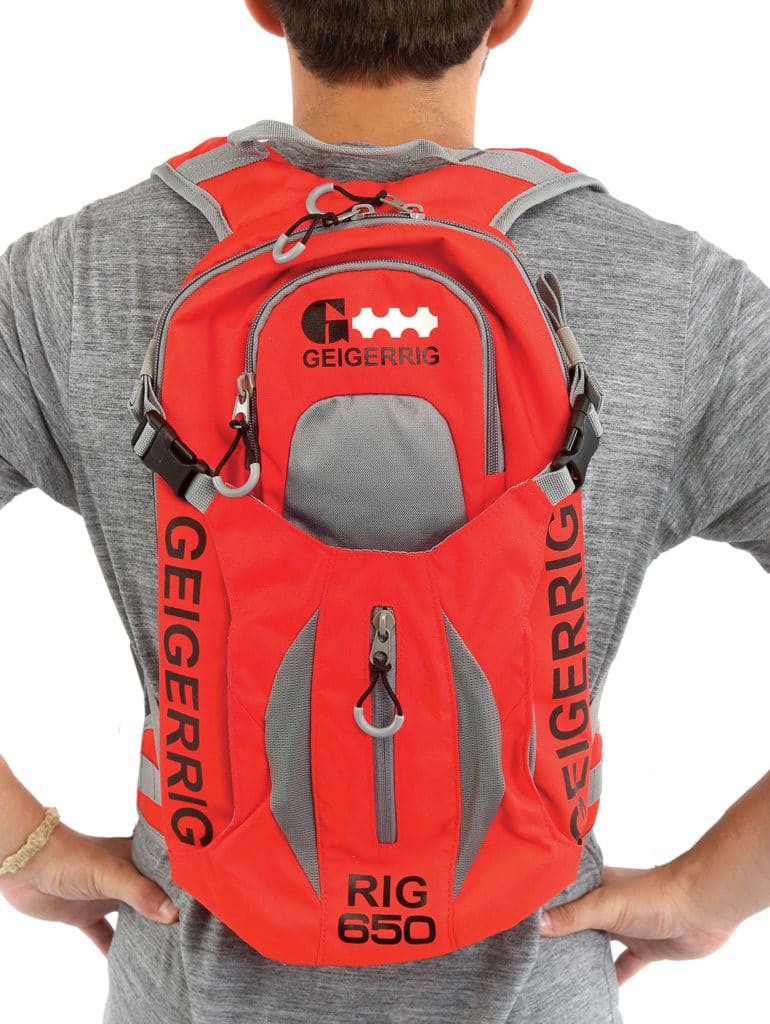
Geigerrig was founded in 2009 when a group of outdoor enthusiasts got together to design a pack that could deliver performance under pressure. Seriously, Geigerrig’s hydration packs feature a unique pressurized bladder that allows the user to spray pressurized water out of a performance hydration pack. You might ask why this would be beneficial. Well, this feature lets riders share water with friends or with a trail pup without swapping saliva. It can also double as a squirt gun if your riding buddies are getting on your nerves. Geigerrig is known for making top-quality packs for military use, as well as for active outdoorsmen. The Rig 650 is Geigerrig’s mountain bike-specific pack.
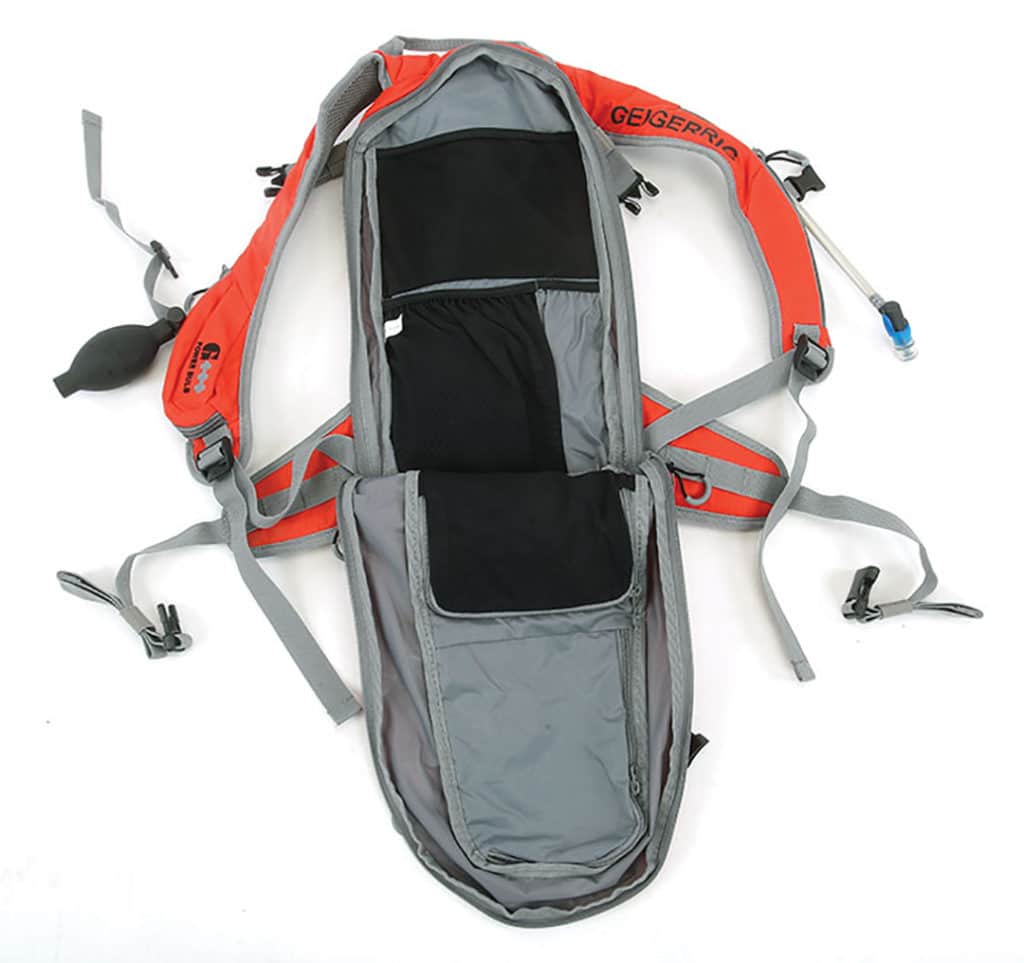
Tech features: The Rig 650 contains a large 3-liter bladder inside of its 650-cubic-inch bag, which is roughly 10 liters. The pack offers plenty of storage, with multiple organizational pockets and a helmet carrier designed to fit anything from a cross-country helmet to a full-face lid. The shoulder straps are padded for comfort, and the combination of a waist strap and sternum strap helps keep the pack securely in place. The Rig 650 features a separate pocket for its bladder system and has a thin back plate that can be slid in for additional protection. The main feature of the Rig 650, however, is its unique bladder system that is pressurized by a Power Bulb hand pump that sits on the shoulder strap. Once pumped up, the bladder will squirt out water when you use the bite valve Additionally, this pack is compatible with the Aquamira Frontier Max filter, which is claimed to make field water safe to drink. The Rig 650 sells for $145.
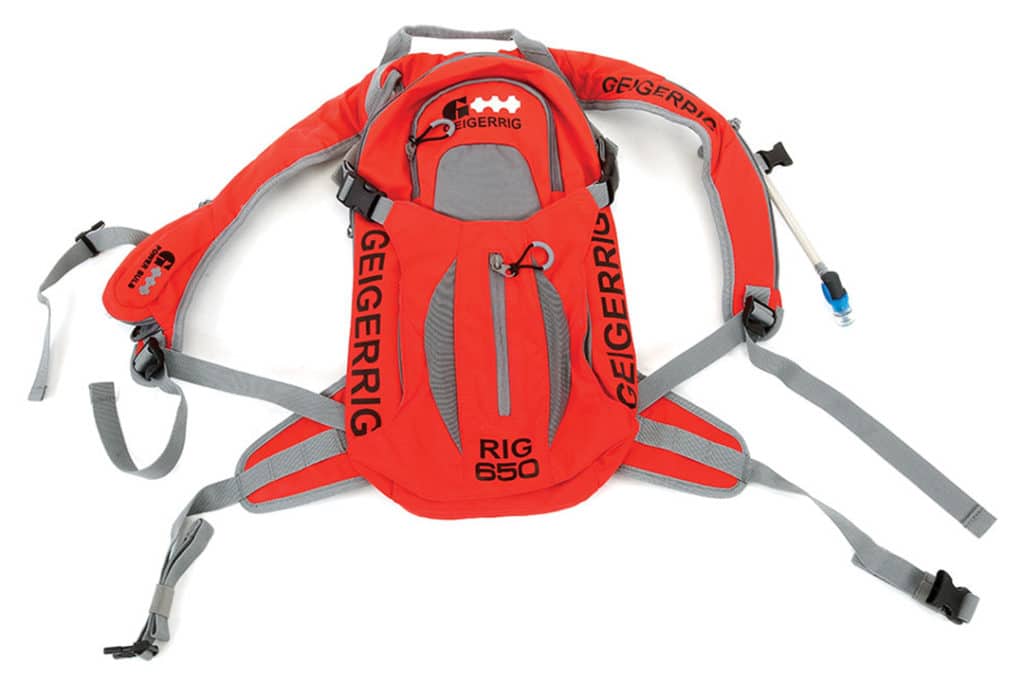
Field test results: The first thing we noticed about the Rig 650 was its quality construction. This pack has a durable feel and tons of room to store all of the items you need for a long day on the trails. Inside the bag are many pockets, so riders can keep everything organized and readily accessible. There’s a slot for a bike pump, a fleece-lined pocket for valuables or glasses, and an outer pocket perfect for car keys or a multi-tool. The Rig 650 ventilates well, making it comfortable to wear on hotter days, and the pressurized bladder works just as it’s claimed to, providing a portable water fountain. This pack may not be for everyone, but if you want to share water with a friend or a pup, then you’ll be hard-pressed to find a better option
THERE ARE SO MANY WAYS TO GET ELECTRIC BIKE ACTION
In print, from the Apple newsstand, or on your Android device, from Google.
Available from the Apple Newsstand for reading on your iPad, iPhone or iPod Touch.
Subscribe Here
For more subscription information contact (800) 767-0345
Got something on your mind? Let us know at hi-torque.com
____________________________________
The post Hydration Pack Shootout appeared first on Electric Bike Action.